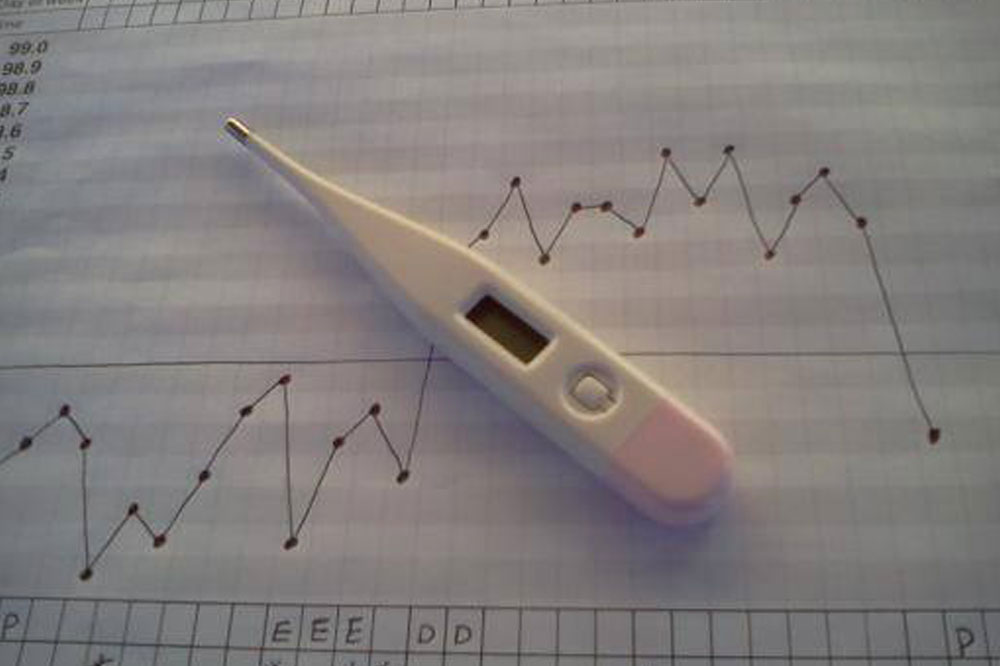Predicting Your Fertility - Basal Body Temperature
If you're trying to get pregnant, knowing the time you are likely to ovulate can help you time intercourse accordingly. Many couples have had success using ovulation predictor kits, which can detect ovulation roughly 36 hours beforehand. Another, more natural way of determining ovulation is charting your Basal Body Temperature (BBT) and monitoring your cervical mucus.

What is ovulation?
Ovulation is when one of your eggs (more if you are preparing to have twins) are released from a follicle that developed in the ovary. The egg then travels down the fallopian tube where it is typically fertilized. During this process your body temperature raises to create a more fertile environment for the egg (due to increased levels of the hormone progesterone).
It can take 24 to 48 hours for progesterone levels to build up enough to raise your body temperature. However, since the egg or ovum is only around for 24 hours, at that point it's too late for fertilization. Charting each day's basal body temperature will help pinpoint your likely ovulatory date and determine future patterns for predicting ovulation. Then you can plan to have intercourse during the 2 or 3 days preceding ovulation. That way, the sperm can already lie in the fallopian tubes, in readiness for when an egg is released, increasing your chances of conception immensely.
How to take your Basal Body Temperature ?
To take your Basal Body Temperature, you need a special (ultrasensitive) BBT thermometer. Such a thermometer is graduated in one-tenth of a degree increments, and is generally inexpensive. Your Basal Body Temperature can be taken either orally or vaginally, with orally being the more accurate method. Whichever you choose, try to keep it consistent throughout the cycle. Also try to place the BBT thermometer the same location in your mouth or the same depth vaginally every day.
Your BBT temperature refers to the temperature of your body at rest - your temperature when you first wake up in the morning. It is recommended that you take your BBT first thing upon awakening, after at least three to four hours of sleep, before doing anything else (or your temperature will fluctuate), as well as avoid eating or drinking.
Your temperature can rise up to one-tenth of a degree for every 30 minutes taken later than normal and fall one-tenth of a degree for every 30 minutes taken earlier than normal. If your temperature wasn't taken at the normal time, adjust it using this rule.
Your temperature can also be affected if you have a fever, if you didn't get a good night's sleep, if you had an alcoholic drink the night before, if you experienced a jet lag and by changes in sleeping habits.
Charting Your BBT Temperature
It is best to start charting on the first day of your menstrual period. If you start in the middle of your cycle, the results may not be reliable and can cause unnecessary confusion. Using a notebook, start recording your BBT Temperature. For each day, write down your temperature, the time it was taken, and any reason for a variation in temperature (if applicable).
Predicting Ovulation
There will be two variations in temperature during a cycle, three if conception has occured. For most women, 96.5 to 97.5 degrees is considered normal during the first two weeks of the menstrual cycle, prior to ovulation and 97.6 to 98.6 degrees after ovulation due to hormonal changes. Post-ovulatory temps will remain high for a period usually 12 to 16 days until they drop again when your cycle ends and menstrual period begins. If pregnancy takes place temperatures will remain elevated throughout the entire pregnancy.
By charting the differences, you can determine when ovulation has taken place. What you are looking for is a temperature shift of at least 0.4 degrees higher than all temperatures the previous six days over a 48-hour period.
After doing a few charts, you should notice a very distinct and predictable pattern of ovulation, which will help you time future intercourse.
Indication of possible Pregnancy
If your Basal Body Temperature remains elevated for 18 days or more after ovulation, you should probably test for pregnancy.
BBT Limitations in Ovulation Prediction
Charting your Basal Body Temperature only tells you when ovulation has already occured. Since an egg can only live for 24 hours, by the time you know you have ovulated, the egg will already be gone (temperature rises are noticeable only 2 days after ovulation). BBT is important for predicting distinct patterns, which, if you have a regular cycle, could help you predicting future ovulations. A more direct means to predict ovulation would be to use an Ovulation Predictor Kit. When charting your Basal Body Temperature, it is most useful to chart other body signs as well, such as your cervical fluid and cervical position. Using these three indicators together will result in a much more accurate indication of your most fertile time!